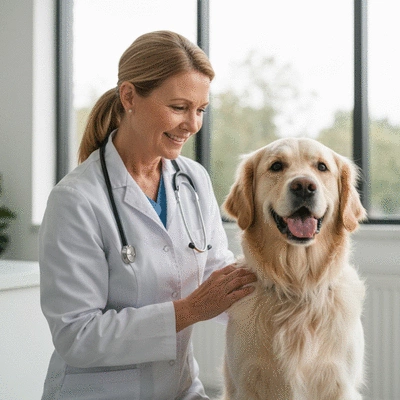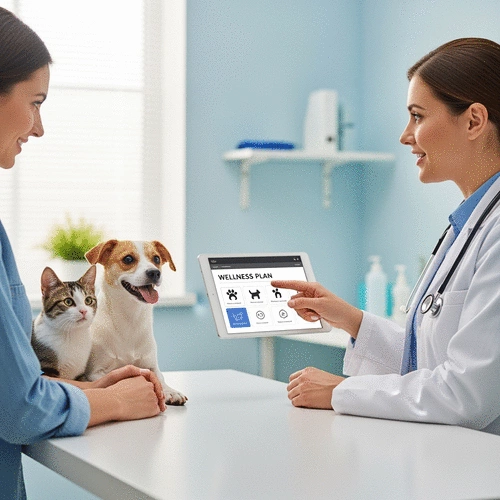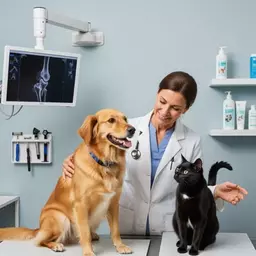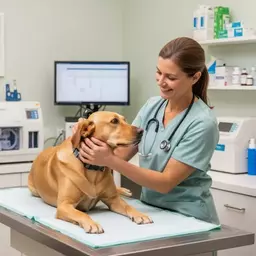What if you could transform your pet's health care experience into a proactive journey? Pet wellness plans are not just a trend; they’re a vital resource for ensuring your beloved companion remains healthy and happy. By understanding these plans, you can take a significant step towards better health outcomes for your pet.
What You Will Learn
- Pet wellness plans focus on preventive care, providing essential routine check-ups and vaccinations.
- These plans improve health outcomes for pets, leading to longer, healthier lives.
- Veterinary clinics benefit from increased client loyalty and predictable revenue streams.
- Understanding the differences between wellness plans and pet insurance is crucial for effective pet care budgeting.
- Integrating wellness plans with insurance creates a comprehensive health care strategy for pets.
- Financial planning is vital for managing costs associated with both wellness plans and insurance, ensuring adequate care for pets.
Pet Wellness Plans vs. Pet Insurance: A Comparative Overview
Understanding the distinctions between pet wellness plans and pet insurance is crucial for comprehensive pet care. This comparison highlights their core differences and how they can complement each other. For those looking to optimize their pet's health strategy, learning how to craft your pet wellness plan can provide invaluable guidance.
Pet Wellness Plans: Proactive Prevention
- ✓ Coverage: Routine care (check-ups, vaccinations, diagnostics).
- ✓ Payment: Pre-paid/monthly fees, predictable costs.
- ✓ Access: Immediate services, minimal out-of-pocket at time of treatment.
- ✓ Focus: Emphasizes preventive care for long-term health.
Pet Insurance: Emergency & Accident Coverage
- + Coverage: Unexpected illnesses, accidents, emergency treatments.
- + Payment: Premiums vary, often with deductibles/reimbursement.
- + Access: Pay upfront, then wait for reimbursement.
- + Focus: Reactive financial relief after a health event.
Combining both offers a comprehensive approach to pet healthcare, ensuring both routine and emergency needs are covered.
Explore Comprehensive Pet CareUnderstanding Pet Wellness Plans and Their Importance for Veterinary Clinics
As a veterinarian with over a decade of experience, I've seen firsthand how essential pet wellness plans are for both pet owners and clinics. These plans serve as a proactive approach to maintaining animal health, making them a valuable asset in the veterinary field. But what exactly are these wellness plans, and why should your clinic consider implementing them?
What Are Pet Wellness Plans?
Pet wellness plans are comprehensive care programs designed to provide preventive services that enhance the overall health of pets. These plans typically include routine check-ups, vaccinations, and diagnostic tests tailored specifically for each pet's needs. By focusing on preventive care, these plans aim to catch potential health issues before they become serious, saving pet owners time, stress, and money in the long run.
- Preventive care services
- Routine health check-ups
- Customized vaccinations based on pet age and health status
- Regular diagnostic tests to monitor health
In essence, pet wellness plans create a structured approach to pet care, ensuring that pets receive consistent monitoring and treatment options that adapt as they age. For more insights into future pet care strategies, explore the 2025 pet wellness trends uncovered.

The Benefits of Pet Wellness Plans for Clients and Clinics
There are numerous advantages for both pet owners and veterinary clinics when it comes to wellness plans. For clients, these plans provide a clearer view of their pet's health needs, often leading to better health outcomes. For clinics, they can enhance client loyalty and create predictable revenue streams. Here are some key benefits:
- Improved health outcomes for pets
- Increased client loyalty and satisfaction
- Predictable revenue for veterinary clinics
- Minimal financial surprises for pet owners
By prioritizing preventive care through these plans, we foster a healthier community of pets while ensuring that our clinics can thrive as well.
How Wellness Plans Support Preventive Care in Pets
Wellness plans are instrumental in shifting the focus from reactive to proactive care. They encourage regular veterinary visits, which help in identifying health issues early on. This preventive approach not only enhances the quality of care but also strengthens the pet-owner relationship. By discussing wellness plans with clients, we can help them understand the importance of routine check-ups and vaccinations.
In fact, many pet owners express relief when they realize that routine visits can lead to earlier diagnosis and treatment of potential health issues. It's a win-win situation!
Key Components of Effective Pet Wellness Programs
To develop an effective pet wellness program, certain key components must be included. These elements ensure that the program provides comprehensive care while also addressing the unique needs of each pet:
- Health Check-ups and Routine Diagnostics
- Incorporating Pet Vaccination into Wellness Plans
Health Check-ups and Routine Diagnostics
Regular health check-ups are a cornerstone of any effective wellness plan. These visits allow veterinarians to monitor pets' health and detect any emerging issues early. Routine diagnostics, such as blood tests and urinalyses, complement these visits, providing additional insights into a pet's overall well-being. By catching potential health problems early, we can minimize discomfort and ensure a longer, healthier life for our furry companions.
Incorporating Pet Vaccination into Wellness Plans
Vaccinations are vital to preventing serious illnesses in pets. They not only protect individual pets but also contribute to the overall health of the community by reducing the spread of infectious diseases. By including vaccinations as part of a wellness plan, we can ensure that pets are protected throughout their lives, reducing the likelihood of unexpected illnesses and costly treatments down the line.
We Want to Hear From You!
Have you considered the impact of pet wellness plans on your pet's health? We'd love to know your thoughts! Share your experiences with wellness plans or any questions you may have:
Comparing Pet Wellness Plans to Pet Insurance
When it comes to managing our pets' health, it's crucial to understand the differences between pet wellness plans and pet insurance. Both serve distinct purposes in overall pet care, but they offer different benefits for pet owners. Wellness plans focus on preventive care, ensuring your furry friend receives the necessary routine checks and treatments. On the other hand, pet insurance primarily covers unexpected illnesses and accidents, providing financial relief during emergencies.
For me, as a veterinarian, it's essential to educate pet owners about these differences. This not only helps them make informed decisions but also enhances their ability to budget for their pets' health. Understanding these plans can be a game-changer in how we approach long-term pet wellness! For a more detailed comparison of diagnostic tools that aid in preventive care, check out veterinary diagnostic tools: a comparison.
Key Differences Between Wellness Plans and Insurance
- Coverage Scope: Wellness plans typically cover routine care such as vaccinations, check-ups, and preventative treatments, while insurance focuses on unforeseen medical expenses.
- Payment Structure: Wellness plans often operate on a pre-paid or monthly fee basis, ensuring predictable costs, whereas insurance premiums can vary greatly and may come with deductibles.
- Reimbursement Process: With insurance, you might pay upfront and wait for reimbursement, while wellness plans usually offer immediate access to services without out-of-pocket costs at the time of treatment.
- Focus on Prevention: Wellness plans emphasize preventive care to maintain health, whereas insurance is reactive, helping you financially after an illness or injury occurs.
These distinctions are essential when considering how to best protect your pet's health. By combining both wellness plans and insurance, pet owners can enjoy a well-rounded approach to their animal's healthcare.

How Wellness Plans Can Complement Pet Insurance
Integrating a pet wellness plan with pet insurance creates a comprehensive strategy for maintaining your pet's health. Wellness plans provide the foundation for regular check-ups and preventive care, while insurance steps in to cover unexpected events. This dual approach can ease financial stress and ensure your pet receives both routine care and emergency treatment.
The harmony of these systems allows pet owners to focus on the health of their pets without the burden of worrying excessively about costs. It's a win-win situation! Let's explore how financial planning can play a role in this effective combination.
The Role of Financial Planning in Pet Care
Effective financial planning for pet care includes understanding the costs associated with both wellness plans and insurance. By considering these expenses as part of your overall budget, you can ensure that your pet receives the best care possible. Here are some tips on how to structure your financial plan:
- Evaluate Costs: Assess the annual costs of wellness plans versus potential insurance premiums and out-of-pocket expenses. This will help you make informed decisions.
- Set Up a Savings Fund: Create a separate savings account specifically for your pet’s health expenses. This can provide a financial cushion for unexpected costs.
- Regularly Review Plans: As your pet ages or their health needs change, revisit your wellness plan and insurance policy to ensure they are still adequate.
- Consult with Professionals: Don’t hesitate to reach out to your veterinarian for guidance on which plans would best suit your pet's needs and your budget.
By strategically planning for your pet's healthcare, you can enjoy peace of mind while ensuring they receive the care they deserve!
Recap of Key Points
Here is a quick recap of the important points discussed in the article:
- Pet wellness plans focus on preventive care, including routine check-ups, vaccinations, and diagnostic tests tailored to each pet's needs.
- Benefits of wellness plans include improved health outcomes for pets, increased client loyalty, and predictable revenue for veterinary clinics.
- Effective wellness programs should include regular health check-ups and vaccinations to ensure comprehensive care.
- Understanding the differences between pet wellness plans and pet insurance helps pet owners make informed decisions about their pet's healthcare.
- Combining wellness plans with pet insurance can create a robust strategy for maintaining your pet’s health and managing costs.
Frequently Asked Questions About Pet Wellness Plans
- What is the main difference between a pet wellness plan and pet insurance?
- Pet wellness plans cover routine and preventive care like check-ups, vaccinations, and diagnostic tests. Pet insurance, on the other hand, is designed for unexpected events such as accidents, emergencies, and serious illnesses.
- What services are typically included in a pet wellness plan?
- Wellness plans generally include annual physical exams, vaccinations, routine lab tests (blood work, urinalysis), parasite prevention, and sometimes dental cleanings or spaying/neutering, depending on the plan level.
- How do pet wellness plans benefit veterinary clinics?
- For clinics, wellness plans lead to increased client loyalty, more consistent patient visits, and predictable revenue streams. They also help foster stronger relationships between veterinarians and pet owners by encouraging regular preventive care.
- Can I have both a pet wellness plan and pet insurance?
- Yes, combining both a pet wellness plan and pet insurance is highly recommended. This approach provides comprehensive coverage, ensuring your pet receives both routine preventive care and financial protection against unexpected medical emergencies.
- How can financial planning help with pet care costs?
- Effective financial planning involves evaluating the costs of wellness plans and insurance, setting up a dedicated savings fund for pet health, regularly reviewing coverage as your pet's needs change, and consulting with your veterinarian for personalized advice. This helps manage costs and ensures your pet receives optimal care without financial strain.










